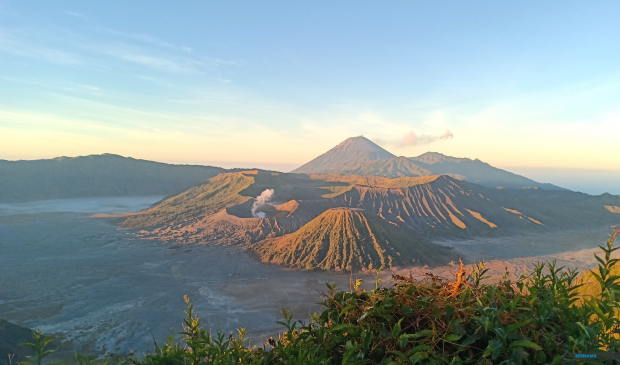Discovering the Gems of East Java

Mt Bromo’s imposing caldera and its surroundings (Bernama)
By Noorazlina Jindeh
Surabaya: Imagine having to skip a good night’s sleep to catch the famed sunrise over the volcanic peaks at the Tengger Semeru National Park in East Java.
This is what a group of 20 journalists and tour agents from Sabah and Sarawak had to do during a recent six-day/five-night familiarisation tour of the tourist attractions in East Java, organised by the Indonesian Ministry of Tourism.
And, as this writer found out, the sleep deprivation was perfectly worthwhile as the view of the sunrise was simply breathtaking and definitely an experience no visitor to this part of Indonesia should miss.
To get to the sunrise viewpoint at Mt Penanjakan at the Tengger Semeru National Park on time, we left our hotel in Kota Batu — about 100 kilometres from Indonesia’s second-largest city Surabaya — at midnight.
About two hours later, we reached Desa Tosari where we disembarked from our coach and rode on four-wheel-drive vehicles to the Mt Penanjakan viewpoint, located 2,777 metres above sea level.
Half an hour later, we reached our destination but the whole area was chock-a-block with vehicles ferrying tourists eager to feast their eyes on the stunning sunrise between 4.30 am and 5.30 am.
In fact, our local tour guide Mohamad Richard Noor, 42, advised us to snap our vehicle’s number plate to enable us to recognise our vehicle later.
To reach the viewpoint proper, we had to walk about 20 minutes but visitors who don’t want to walk can opt for the motorcycle service at 10,000 rupiahs (about RM2.90) per person.
It was 4 am and with the temperature below 10 degrees Celsius, it was freezing cold but, fortunately, there are locals there who earn an income by renting out blankets and cushions 25,000 rupiahs (about RM7.40).
Panoramic views
The Mt Penanjakan viewpoint is so popular that it resembles a mini-stadium, with capacity for 800 people. The views from this vantage point do not disappoint — from here one can gaze at the peaks of Mt Semeru, one of Indonesia’s most active volcanoes and the highest mountain in East Java at 3,600 metres high; Mt Watangan (2,662 m); Mt Widodaren (2,614 m); Mt Segara Wedi (2,581 m); Mt Batok (2,440 m); and the most popular of them all, Mt Bromo (2,392 m) which is also an active volcano.
When the deep orange hues of the sun’s rays fell on the mountain range in the foreground, Mt Bromo’s imposing caldera and its surroundings came into view — the scenery literally taking our breath away. Plumes of smoke could be seen streaming from the crater.
Mt Bromo is usually accessible to hikers who can walk up to its caldera but at the time of our visit to Tengger Semeru National Park, the hiking track to Mt Bromo was temporarily closed following an eruption in February this year.
In fact, we were told to wear masks to avoid breathing in the volcanic dust carried by the wind blowing from the mountains.
Our next stop was ‘Whispering Sands’, a must-visit area located about 2,000 metres above sea level and a 20-minute drive from the Mt Penanjakan viewpoint. Set against the beautiful backdrop of Mt Batok, an inactive volcano, ‘Whispering Sands’ comprise sand dunes located on the east of the Mt Bromo caldera.
Colourful Malang
Our next destination was Malang, one of the nine cities located in East Java province.
Essentially a university town, Malang is also known for the colourful villages of Jodipan and, across the bridge over the nearby Brantas river, Tridi.
The interesting thing is until about three years ago, these two villages used to be slum areas but today, they are attracting hordes of tourists, thanks to a makeover initiated by a group of students from a university in Malang in June 2016.
According to our guide Mohamad Richard, the students managed to team up with a local paint manufacturer and together with the support of the villagers, they embarked on repainting the tiny houses there in vibrant shades and decorating the walls with eye-catching abstract artworks.
In fact, every corner of the village and even the drab and dark alleys have been transformed with a fresh coat of brightly-coloured paint and decor.
Visitors are charged 3,000 rupiahs (about 88 sen) each as entrance fee and are given a handcrafted keychain as a token of appreciation.
“The proceeds from the fees collected are used for maintenance purposes to keep the villages clean and beautiful,” said Mohamad Richard, who has been working as a tour guide since 1996.
Ceramic industry
We also had the opportunity to visit Kampung Keramik Dinoyo in Malang where about 30 craftsmen can be found still making ceramics using the traditional techniques. All of them operate from their houses.
Ceramics artisan Syamsul Arifin, 59, who inherited the trade from his family in 2000, said he can produce an average of 600 ceramic vases a week, priced at between 10,000 rupiahs and 250,000 rupiahs (about RM2.95 and RM74).
The ceramics industry here had its beginnings in the 1930s and the craftsmen use locally sourced white clay to make a host of items like vases and aromatherapy diffusers that are decorated with colourful flora and fauna motifs.
BERNAMA
























































